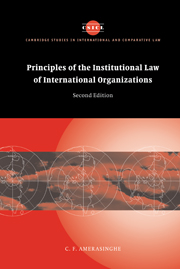Book contents
- Frontmatter
- Contents
- Preface
- List of abbreviations
- Table of cases
- 1 Introduction
- 2 Interpretation of texts
- 3 Legal personality
- 4 Membership and representation
- 5 Non-Judicial organs of organizations
- 6 Acts of non-judicial organs: their legal effect
- 7 Acts of non-judicial organs: the doctrine of ultra vires
- 8 Judicial organs
- 9 The internal law: employment relations
- 10 Privileges and immunities
- 11 Financing
- 12 Responsibility to and of international organizations
- 13 The liability of member states vis-à-vis third parties
- 14 Amendment of constitutions
- 15 Dissolution and succession
- 16 The settlement of disputes
- Index
- Cambridge Studies in International and Comparative Law
15 - Dissolution and succession
Published online by Cambridge University Press: 10 December 2009
- Frontmatter
- Contents
- Preface
- List of abbreviations
- Table of cases
- 1 Introduction
- 2 Interpretation of texts
- 3 Legal personality
- 4 Membership and representation
- 5 Non-Judicial organs of organizations
- 6 Acts of non-judicial organs: their legal effect
- 7 Acts of non-judicial organs: the doctrine of ultra vires
- 8 Judicial organs
- 9 The internal law: employment relations
- 10 Privileges and immunities
- 11 Financing
- 12 Responsibility to and of international organizations
- 13 The liability of member states vis-à-vis third parties
- 14 Amendment of constitutions
- 15 Dissolution and succession
- 16 The settlement of disputes
- Index
- Cambridge Studies in International and Comparative Law
Summary
While it is to be expected that the existence of an international organization would come to an end when it has completed its task or when another organization is established to perform the same or similar functions, this is not always the case. Effectively an organization could be dissolved when its membership wishes to do so and the unwillingness of most of the members to continue participation in an organization, for whatever reason, could lead to dissolution. There are several instances of dissolution of organizations, though not for the latter reasons, because the assumption is that once an organization is established the functions performed will continue to be required for international society. The LN was dissolved by agreement of the members in 1946 but the UN virtually took its place. The ICAN was also dissolved in 1946, as was the IIA by a decision of its Assembly, and the East African Common Services Organization ceased to exist in 1967 under the terms of the Kampala Treaty. But in these cases some other organization in effect continued the functions of the dissolved organization. Organizations may cease to exist by absorption (e.g., the IBE by the UNESCO in 1969 and the IPI by the EPO in 1978), or by merger (e.g., the ESRO and the ELDO into the ESA in 1975), there being also in effect a dissolution which took place in these cases.
- Type
- Chapter
- Information
- Publisher: Cambridge University PressPrint publication year: 2005

